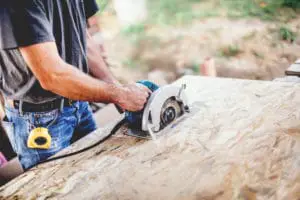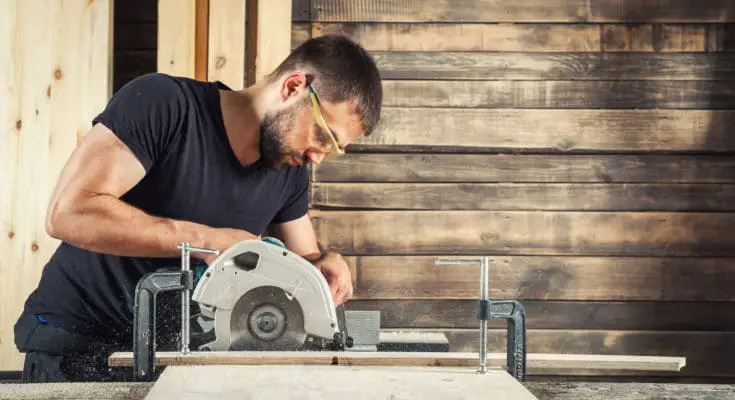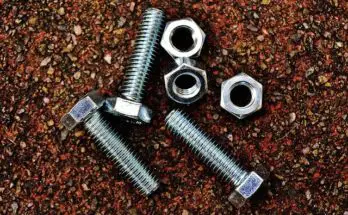One of the most difficult things for a new woodworker to learn is what tools and saws they need. Manufacturers have flooded the market with all different types of machines and gadgets which add to the confusion of what you truly need and what you don’t.
One of the most common tools that you will find in not just a shop, but even most homes is a circular saw. It’s one of the most popular saws on the market. The popularity for this saw is directly due to due to it’s versatility and relative inexpensive cost.
Below we will cover the basics of what a circular saw is, but most importantly help you determine if you need to purchase a circular saw for the types of projects you do.
Brief History
Unlike most inventions, the inventor of the circular saw is a mystery. No single person is credited with creating it. It is believe that the saw was created by loggers and sawmills as a method to convert logs into lumber in a more efficient manner.
Today, variations of the circular saw are used daily across a wide variety of industries. Variations of a circular saw are used in everything from concrete design to even operating rooms to perform some surgeries.
Circular Saw Uses and Benefits
If you’ve ever hired a contractor for a job, one of the first tools he will pull out if lumber is involved is a circular saw. A circular saw is a portable version of a miter and table saw. Table saws and miter saws are very important tools if you need precise cuts, but as you’ll see, a circular saw is likely good enough for most jobs.
Here are the key uses and benefits of a circular saw:
Uses
- Rip Plywood – The typical sheet of plywood measures 4 feet by 8 feet in size. Unless you are putting down subfloors, you’re probably going to need to cut a piece of plywood down into more manageable sizes. A circular saw will do that for you. You simply mark a straight line on your wood to indicate where you want to cut. Then line up the guides on your circular saw to that line. Power it on, and move the saw along the line using your guides. In just a few minutes you can easily have the 4×8 sheet of plywood into much smaller pieces.
- End Cutting – A circular saw is also perfect to use when cutting lumber (such as a 2×4) into small sections. These cuts are referred to as “cross cuts” because they are going against the grain. You’ll just need to hold or clamp your piece of wood down and line up the saw’s guides to where you want to cut the lumber.
- Clean up – If you’ve ever watched a new wood privacy fence get installed, you may have noticed the workers cementing the posts into the ground and not worrying about how much of the wooden post is sticking out of the ground. After a few posts have been set, you’ll see that some posts are 6.5’ above the ground, another one might be 7’ and so on. They do this so that after the posts are set, they can go back and measure each post to a specific height above the ground. In our example, let’s assume 6 feet. The worker will mark each post 6 feet above the found. Another worker will come behind him and cut each of these posts on the marked line so all the posts are of equal height. The saw used for this, is the circular saw due to it’s speed and light weight.
- An additional example of this is building a table. If you’ve ever watched someone build a table top, chances are they have glue or joined all of the boards together while leaving the ends of varying lengths. This is done to ensure the ends are cut to exact, even lengths. Just before the carpenter is ready to sand and stain the table top, he/she will measure a straight line across the ends of the table and cut along the line. This will create a perfectly straight edge for the table.
Benefits
- Portability – Circular saws are the perfect saw to have when you have a project that will require you to move around. An example of this is outdoor projects such as building a wooden fence or deck. Often times, your working position will change constantly on these projects, so have a saw that you can easily pick up and drop nearby is crucial to saving time. A miter saw can be used on these projects, but they just aren’t as portable as the circular saw.
- Cost – You can pick up a corded circular saw for under $75. That’s a great price for a saw that is as versatile as the circular.
- Easy storage – Given a circular saw’s size, it is very easy to store in home. It’s takes up very little space compared to other saws. These will easily fit into a cabinet when you aren’t using them.
Circular Saw Limitations
As great as circular saws are, they do have some limitations, but not many. Their primary limitation is that their cuts may not always be extremely precise. This is because you are using the guides built into the plate on the saw and “eyeing it up” with your market cut line. This is less of a factor on jobs such as fences or decks because no one is going to be able to see a minor variance in your cut. Where this would create a problem is projects where more precise cuts are needed such a building furniture, cutting trim and molding, or even picture frames.
Do I need a circular saw?
Ultimately, this is a decision that you will have to make. If you do any projects around your house that require lumber or plywood, I’d recommend picking up a circular saw. A circular saw is going to be the cheapest and take up the least amount of space of any electric saw that you can get.
What size circular saw do I need?
Once you decide you want to get a circular saw, you’ll want to decide what size you need. This really isn’t as difficult as it may sound. There are 2 primary sizes that circular saws come in. The larger saws that are used to cut lumber and plywoods come in 6 ½” and 7 ¼” sizes (sometimes referred to as 6 ½” and 7 ¼”. The most common of these two is the 7 ¼”. This size will give you the most options when it comes to looking for a blade. The 7 ¼” blades are also typically cheaper as well.
There are three primary differences between a 6 ½“ and 7 ¼” saw.
- Cutting depth – Given the larger blade, the 7 ¼” blade can cut significantly deeper than a 6 ½”. A 7 ¼” blade can typically cut to a depth of about 3”. The 6 ½” blade has a cut depth of around 2.25” inches.
- Weight – On average, a 7 ¼” saw is going to weigh about 1 – 1.5 lbs more than the smaller saw. This doesn’t sound like much, but it can be significant if you are having to make a large number of cuts in hard to reach and/or awkward locations.
- Bevel Cuts – On most saws, the bevel cut is about 10-15 degrees more limited on the 6 ½” saws. These saws typically have a make bevel angle of around 50 degrees.
While shopping for a new saw, you’ll also see some smaller circular saws than the two mentioned above. These will come in 3 ½” and 4 ½” sizes. These saws are more commonly used for cutting small pieces of wood such as trim and molding. These saws are not recommended for larger pieces of wood.
Type of circular saws
If you feel you have a need for a circular saw, you have a couple different options to consider when finding which saw is right for you. The first decision that you’ll want to make is whether you want an electrical or battery powered saw. Each have their own pros and cons.
Cordless
The primary benefit to getting a cordless or battery powered circular saw is not having to deal with the cord. This allows you to not have to worry about cutting through the cord and eliminates the worry for having find a power source. If you have projects that are out in a field or far from your house/shop, then I would highly recommend going with a cordless option.
If you aren’t looking to get a set of tools and only want a cordless circular saw, I’d recommend this one by DeWalt that can be found on Amazon. It comes with everything you need – including a battery and charger. You’ll find cordless saws on Amazon for much cheaper prices but they will say “Tool Only.” This indicates that you are only purchasing the circular saw and not the battery or charger, which can at times be pricey. This DeWalt model is plenty powerful enough to cut through any lumber or plywood that you are using in your next project. It uses a 6.5” blade. Pay attention to the blade size of whatever unit you purchase. Manufacturers have begun producing different sized units in recent years, so you’ll want to make sure any additional blades you pick up for your saw will fit.
The obvious negative to going with a cordless drill is that you have to remember to keep your battery charged. Once your battery starts showing some age, it holds less and less power. Battery replacement can be rather expensive when the time comes that you need a new one. One thing that you can do to offset the need for keeping one battery charged at all times is to buy a package of tools that all use the same batteries. These sets allow you to interchange the battery from tool to tool and make it less likely that you will be completely out of a change when you need one. The best all around cordless tool set package that I have found is this one by Makita.
What I like about this particular set is that it gets you 4 tools that you are going to use most often. I think the reciprocating saw is one of the most underrated saws around. Once I picked one up for a project and I find myself using it all the time. The great thing about buying a bundled set of tools is that you can save some money versus buying them individually. However, don’t fall into the trap of buying the biggest bundle if you don’t think you are going to use the tools. It’s easy to get excited about all the tools a particular bundle comes with and just clicking the “Submit order” button.
Corded
If budget is your primary focus when buying a circular saw, then you’ll want to check out the corded versions of the saw. These are much cheaper because you don’t have to worry about the expensive battery and chargers that the cordless versions require. The only drawback on these models is making sure you have a power source and you don’t cut through the cable when you are using the saw.
There’s several options to choose from among corded circular saws. This 15 amp saw made by Skil is a great buy for the price. I like that it has a laser beam guide to help line up your cut. This is a great feature for people that are new to circular saws or anyone using a circular saw in a tight location.
Circular Saw Safety
As with all power tools, safety is very important to keep in mind. Circular saws can be dangerous if not used properly. The most common injury from using them is cuts on the hands and fingers due to them coming into contact with the blade. When operating a circular saw, make sure the blade guard remains engaged at all times and closes completely before laying the saw down after a cut. Never remove the blade guard in order to make a cut.
Another common issues that can arise when using a circular saw is referred to as a “kickback.” This occurs when the piece of wood that is being cut shifts and pinches the blades. When this occurs, the rotating blades will grab the board and kick it back towards the operator. This

can be dangerous in a couple ways. The operator could become injured from the wood flying back at them. Or they could be surprised by the sudden shift in the wood causing them to react and accidentally coming into contact with the spinning blade.
Before cutting your board, always make sure there is nothing in the path of your cut both above AND BELOW the board. Many times, people fail to check under their board and don’t realize the table or saw hoses they are using are in the direct path of their cut.
Always make sure you have secured your board before cutting to prevent movement and unexpected shifts. Clamping your board to a sawhorse or table is the best way to prevent movement.
Prior to cutting, make sure you have a plan in your head of what’s going to happen when you near the end of your cut. This is especially true when cutting plywood. When you begin getting near the end of your cut, the boards are going to want to fall. This could cause the board to break or crack on the end due to the weight being support. In these cases, it is advised to have a second person around to help hold the boards in place to prevent them from falling if clamping them is not an option.
When using a circular saw, it is recommended that you use eye and ear protection. If you don’t have eye and ear protection, I recommend these glasses and these ear muffs. Both are very well priced.
Circular Saw Accessories
Unlike most other tools, there are not many accessories on the market for users to purchase for their circular saws. You can buy saws with various cut angle abilities as well as laser to show where your cutting, but all of those items come with the saw. If your circular saw doesn’t come with these accessories, there’s really no way to add them afterwards.
The one accessory that you can purchase is called a circular saw guide. These are very handy to have if you do a significant amount of cutting. They work by clamping to the board you are cutting. Then you saw runs along the guide to ensure you get a straight cut. There are several brands to choose from on these guides. The guide that I recommend is this one made by Kreg. It allows you to make perfect parallel and straight cuts when cutting boards or plywood. It’s also one of the better priced guides on the market.
Common related questions
Can a circular saw cut metal? – Yes, you can cut metal with a circular saw IF you have the correct blade. A wood cutting blade will NOT work on metal and will destroy your blade. You can pick up metal cutting blades like this one, at most retailers.
Can a circular saw cut stone or concrete? – Yes, a circular saw can cut either of these materials. Again, the most important thing to remember is that you are using the correct blade such as this one.
Can circular saw blades be sharpened? Yes, blades can be sharpened, however you need to make sure it’s worth the cost and effort to do so. I wrote an article that you can find by clicking here that explains everything you need to know.




